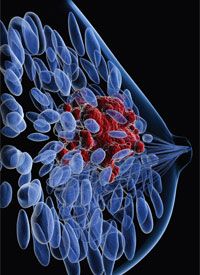Article
NICE Recommends Atezolizumab Combo in Frontline TNBC
Author(s):
The UK's National Institute for Health and Care Excellence has recommended the combination of atezolizumab and nab-paclitaxel as a treatment for patients with unresectable, locally advanced, or metastatic triple-negative breast cancer whose tumors express PD-L1 at a level of 1% or more and have not had prior chemotherapy for metastatic disease.
breast cancer

The UK's National Institute for Health and Care Excellence (NICE) has recommended the combination of atezolizumab (Tecentriq) and nab-paclitaxel (Abraxane) as a treatment option for patients with unresectable, locally advanced, or metastatic triple-negative breast cancer (TNBC) whose tumors express PD-L1 at a level of 1% or more and have not had prior chemotherapy for metastatic disease.
"Atezolizumab plus nab-paclitaxel is considered to be a life-extending treatment at the end of life. The cost-effectiveness estimates are within what NICE considers an acceptable use of [National Health Service] resources," NICE stated in its final appraisal document. "Therefore, atezolizumab with nab-paclitaxel is recommended."
The decision overturns a previous opinion by NICE granted in October 2019, in which the agency stated that it would not recommend the combination as a treatment regimen for this patient population, explaining that it was not cost effective. It also stated it would not include the combination in the Cancer Drugs Fund.
In the final appraisal document, NICE stated that the combination is recommended only if Genentech (Roche), the manufacturer of the PD-L1 inhibitor, provides atezolizumab according to the commercial arrangement, which makes atezolizumab available to the National Health Service (NHS) at a discounted price. The list price for atezolizumab is £2,665.38 ($3,243.15) per 840 mg/14 ml vial.
While PD-L1 testing is not part of routine clinical practice in the United Kingdom, NICE stated in its document that, "The clinical experts and the Cancer Drugs Fund clinical lead explained that introducing PD-L1 testing for people with triple-negative breast cancer would not be problematic, and that the currently used diagnostic tests could be used. Although additional training and resources would be needed, the testing would have a limited impact on the workflow in laboratories. The committee concluded that there would be no major barriers to introducing PD-L1 testing in people with triple-negative breast cancer."
In March 2019, the FDA approved the combination of atezolizumab and nab-paclitaxel for the treatment of patients with unresectable, locally advanced, or metastatic, PD-L1—positive TNBC. The approval is based on the phase 3 IMpassion130 trial, in which the addition of the PD-L1 inhibitor to nab-paclitaxel reduced the risk of progression or death by 40% compared with nab-paclitaxel alone in this patient population.
The double-blind IMpassion130 study evaluated the efficacy and safety of the PD-L1 inhibitor plus chemotherapy versus nab-paclitaxel alone in treatment-naïve patients with metastatic TNBC. Patients were randomized 1:1 to receive nab-paclitaxel at 100 mg/m2 intravenously on days 1, 8, and 15 of the 28-day cycle with atezolizumab at 840 mg intravenously (n = 451) on days 1 and 15 of a 28-day cycle or with placebo (n = 451). Treatment was given until disease progression or unacceptable toxicity.
The coprimary endpoints were progression-free survival (PFS) and overall survival (OS) in both the intent-to-treat (ITT) and PD-L1—positive populations; secondary endpoints were overall response rate, duration of response, and safety. Patients were stratified by prior taxane use, liver metastases, and PD-L1 expression, which was defined as at least 1% on tumor-infiltrating immune cells to be positive.
Results of the primary PFS analysis in the PD-L1—positive population demonstrated a clinically meaningful median PFS of 7.4 months with atezolizumab/nab-paclitaxel and 4.8 months with chemotherapy (HR, 0.60; 95% CI, 0.48-0.77; P <.0001). Moreover, the 1-year PFS rates were 29% (95% CI, 22%-36%) and 16% (95% CI, 11%-22%) with atezolizumab/nab-paclitaxel and nab-paclitaxel, respectively.
In the ITT population, the median PFS with atezolizumab/nab-paclitaxel and nab-paclitaxel was 7.2 months (95% CI, 5.6-7.5) and 5.5 months (95% CI, 5.3-5.6), respectively (HR, 0.80; 95% CI, 0.69-0.92; P = .0025). Moreover, the 1-year PFS rates were 24% (95% CI, 20%-28%) in the combination arm and 18% (95% CI, 14%-21%) in the nab-paclitaxel arm.
At a 12.9-month follow-up, an interim OS analysis of the PD-L1—positive population showed a clinically meaningful improvement with added atezolizumab at 25.0 months versus nab-paclitaxel alone at 15.5 months (HR, 0.62; 95% CI, 0.45-0.86). Two-year OS rates were 54% and 37% in the immunotherapy/chemotherapy and chemotherapy arms, respectively. In the ITT population, the P value for OS was .0840 (HR, 0.84; 95% CI, 0.69-1.02). However, OS was not formally tested in a statistical design in the PD-L1–positive subgroup, but was tested in the overall study population.
To be eligible for enrollment, patients must have had metastatic or inoperably locally advanced TNBC with no prior therapy for their advanced disease with an ECOG performance status of 0 or 1. Prior chemotherapy in the curative setting, including taxanes, were permitted if the treatment-free interval was longer than 12 months.
Regarding safety, most all-grade adverse events (AEs) were similar between arms. The most common grade 3/4 AEs with atezolizumab/nab-paclitaxel and nab-paclitaxel were neutropenia (8% vs 8%), decreased neutrophil count (5% vs 3%), peripheral neuropathy (6% vs 3%), fatigue (4% vs 3%), and anemia (3% vs 3%), respectively.
References
- Final appraisal document: atezolizumab with nab-paclitaxel for treating PD-L1-positive, triple-negative, advanced breast cancer. National Institute for Health and Care Excellence. Published May 22, 2020. https://bit.ly/3bUHcv7. Accessed May 22, 2020.
- Schmid P. IMpassion130: Results from a global, randomised, double-blind, phase 3 study of atezolizumab (atezo) + nab-paclitaxel (nab-P) vs placebo + nab-P in treatment-naive, locally advanced or metastatic triple-negative breast cancer (mTNBC). In: Proceedings from the 2018 ESMO Congress; October 19-23, 2018; Munich, Germany. Abstract LBA1_PR.








